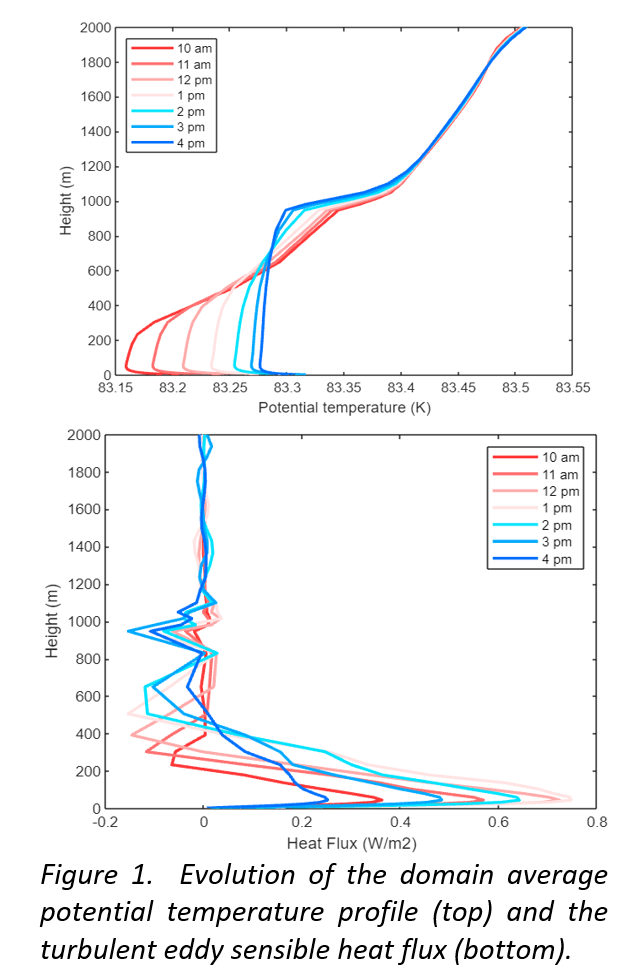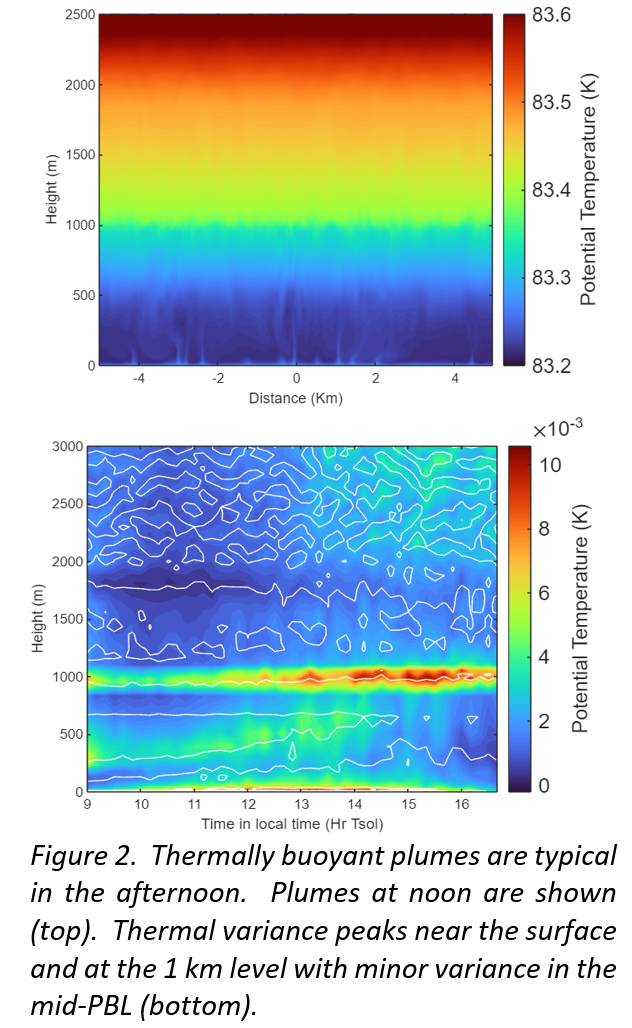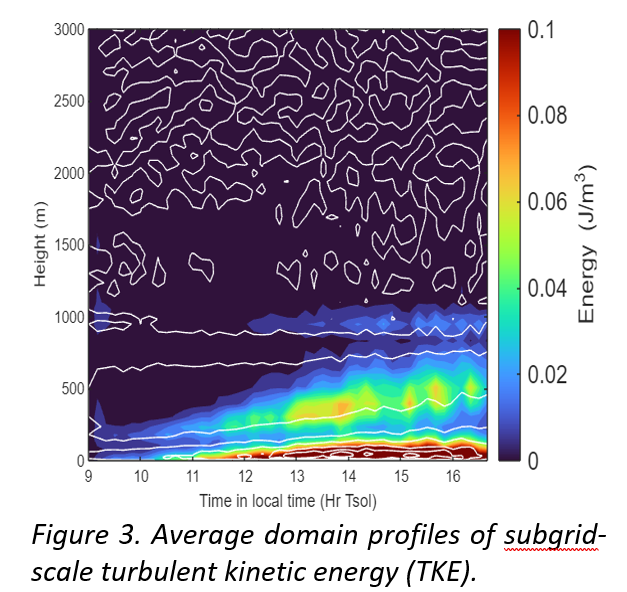The Structure and Evolution of Titan’s Daytime Planetary Boundary Layer
- 1Southwest Research Institute, Space Studies, United States of America (scot.rafkin@swri.org)
- 2Centro de Investigación Científica y de Educación Superior de Ensenada, México
Summary: The structure and evolution of Titan’s planetary boundary layer (PBL) are investigated through large eddy simulation (LES) modeling. The PBL is the interface between the surface and the free atmosphere through which energy, mass, and momentum are exchanged. Results from LES studies forced by diurnally-varying radiation are presented. The development of three distinct PBL layers are noted: 1) a near-surface layer dominated by frictional dissipation; 2) a mixed-layer of near neutral stability; and 3) an entrainment layer capping the top of the PBL. The three layers are similar in character to what is often observed in the Earth’s convective PBL. The depth and evolution of these layers is strongly affected by the initial thermal conditions, the surface thermophysical properties, and soil moisture.
Background and Motivation: The PBL is the lowest atmospheric layer and is critical to the exchange of mass, momentum, and energy between the surface and the atmosphere. Thus, the structure, evolution, and dynamics of Titan’s PBL is relevant to understanding numerous physical processes on Titan, including but not limited to:
- Volatile evaporation from damp regolith and lakes, and contributions to the global volatile cycle;
- Dunes and other aeolian formations, and waves upon lakes driven by turbulent surface wind stress;
- Conversion of surface insolation to atmospheric heating through turbulent fluxes;
In addition, missions that descend through and operate on the surface or in the atmosphere have in interest in predictions of the turbulent structure and evolution of the PBL in both the horizontal and vertical. These predictions are relevant to the engineering design and operational planning of Dragonfly, and the predictions can be largely verified through the measurements that will be made by Dragonfly when it explores Titan.
The sounding from the Huygens probe provides the only direct, vertically resolved measurement of the structure of the PBL at a single moment in time. How the observed structures develop and evolve remain uncertain, and the turbulent exchange processes are challenging to constrain from the single profile. LES techniques provide a mechanism for understanding the observed structure and dynamics of the PBL.
Methodology: The PBL structure and evolution are investigated through LES using a version of the mesoscale Titan Weather, Research, and Forecasting (mtWRF) model (Rafkin and Soto, 2020). mtWRF has been undergoing rapid development with the addition of radiative transfer (Chatain et al., 2022), topography (Moisan et al., 2024), and realistic 3-D lake geometries (Chatain et al., 2024). In this study, we add the capability for soil moisture and prognostic latent heat fluxes and we configure mtWRF with LES grid spacing of 10 to 40 m. The baseline simulation uses a dry regolith (no latent heat flux). Simulations with the addition of a moist surface are compared against the dry scenario. Since LES of Titan is a mostly unexplored area of research, the simulations are conducted in 2-D in order to speed analysis and discovery. The simulations will be extended to 3-D once the PBL dynamics are better understood in 2-D.
The model is homogeneously initialized with a Huygens HASI sounding (Fulchignoni et al., 2002) over a vertical domain of 6 km and a horizontal domain of 40 km with 20 m spacing. Starting at ~0945 local time (LT) when the HASI sounding is valid, the model is integrated until sunrise the following day. Restarting from that point, the model is integrated again until sunset and the results of the daytime PBL evolution are analyzed.
Results: In the baseline, dry regolith case, the daytime boundary layer grows to a depth of ~1 km. The lowest ~100 m are slightly superadiabatic with the bulk of the PBL showing a near neutral profile (Fig. 1). The top of the PBL exhibits an entrainment layer where the free atmosphere above the PBL is mixed downward.
The peak eddy heat flux is found just above the shallow superadiabatic layer and then decreases rapidly toward zero (Fig. 1). Narrow, thermally buoyant plumes with perturbations of ~0.1 K over ambient are evident (Fig. 2). The maximum variance near the surface is explained by the plumes that originate in this layer. The maximum aloft is the result of gravity waves triggered by the convection below and which are trapped in the stable region at 1 km. The subgrid-scale turbulent kinetic energy (TKE) is similar to the thermal perturbations but shows a maximum value in the near-surface layer with a secondary maximum in the middle of the PBL (Fig. 3). The 1 km level has yet another local maximum of TKE, but is subdued compared to the thermal variance (Fig. 2).



References:
Chatain, A., Rafkin, S.C., Soto, A. and Hueso, R., 2022, March. Mesoscale climate modeling above a methane lake on Titan. In Lunar and Planetary Science Conference.
Chatain, A., Rafkin, S.C., Soto, A., Moisan, E., Lora, J.M., Le Gall, A., Hueso, R. and Spiga, A., 2024. The impact of lake shape and size on lake breezes and air-lake exchanges on Titan. Icarus, 411, p.115925.
Fulchignoni, M., Ferri, F., Angrilli, F., Bar-Nun, A., Barucci, M.A., Bianchini, G., Borucki, W., Coradini, M., Coustenis, A., Falkner, P. and Flamini, E., 2002. The characterisation of Titan's atmospheric physical properties by the Huygens Atmospheric Structure Instrument (HASI). Space Science Reviews, 104.
Moisan, E., A. Chatain, A. Spiga, S. Rafkin, A. Soto, and R. Hueso, 2024. Titan’s methane: from lakes to clouds. EPSC 2024.
Rafkin, S.C. and Soto, A., 2020. Air-sea interactions on Titan: Lake evaporation, atmospheric circulation, and cloud formation. Icarus, 351.
How to cite: Rafkin, S., Soto, A., and Chin-Canche, G.: The Structure and Evolution of Titan’s Daytime Planetary Boundary Layer, Europlanet Science Congress 2024, Berlin, Germany, 8–13 Sep 2024, EPSC2024-624, https://doi.org/10.5194/epsc2024-624, 2024.